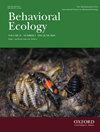高度防卫的裸鳃鱼 "逃 "到视觉上独特的背景栖息地
IF 2.2
3区 环境科学与生态学
Q2 BEHAVIORAL SCIENCES
引用次数: 0
摘要
逃逸和辐射 "假说预言,一旦物种进化出 "隐形 "能力,防御物种就能利用视觉上更加多样的视觉背景,因为它们 "逃逸 "了伪装的需要。这使物种能够探索新的生态位,从而提高物种多样化率。为了验证这一假说的 "逃避 "部分,我们研究了 12 个裸鳃软体动物物种的背景栖息地是否因化学防御的存在和强度而有所不同。我们利用定量色彩模式分析(QCPA)获得了丰富的色彩模式统计数据,以分析通过潜在捕食者(鲀,Rhinecanthus aculeatus)的眼睛观察到的背景。色彩模式分析是在模拟不断升级的捕食序列的观察距离下进行的。我们确定了由 17 个非相关颜色模式参数组成的四个潜在因子,它们捕捉到了与化学防御差异相关的物种间变异。我们发现,有化学防御能力的物种确实是在视觉上不同的背景上被发现的,其颜色和亮度对比增加,与观察距离无关。但是,我们没有发现任何证据表明物种间背景多样性的增加与化学防御的存在和强度有关。我们的研究结果与 "逃逸和辐射 "假说一致,表明多丽德海裸鳃动物的强化学防御与潜在捕食者感知到的视觉背景生境的空间色度差异相吻合。本文章由计算机程序翻译,如有差异,请以英文原文为准。
Highly defended nudibranchs ‘escape’ to visually distinct background habitats
The ‘escape and radiate’ hypothesis predicts that once species have evolved aposematism, defended species can utilise more visually diverse visual backgrounds as they ‘escape’ the need to be well camouflaged. This enables species to explore new ecological niches, resulting in increased diversification rates. To test this hypothesis’ ‘escape’ component, we examined whether the background habitats of 12 nudibranch mollusc species differed among species depending on the presence and strength of chemical defences. We obtained a rich array of colour pattern statistics using Quantitative Colour Pattern Analysis (QCPA) to analyse backgrounds viewed through the eyes of a potential predator (triggerfish, Rhinecanthus aculeatus). Colour pattern analysis was done at viewing distances simulating an escalating predation sequence. We identified four latent factors comprising 17 non-correlated colour pattern parameters, which captured the among-species variability associated with differences in chemical defences. We found that chemically defended species, indeed, were found on visually distinct backgrounds with increased colour and luminance contrast, independent of viewing distance. However, we found no evidence for increased among-species background diversity coinciding with the presence and strength of chemical defences. Our results agree with the ‘escape and radiate’ hypothesis, suggesting that potent chemical defences in Dorid nudibranchs coincide with spatiochromatic differences of visual background habitats perceived by potential predators.
求助全文
通过发布文献求助,成功后即可免费获取论文全文。
去求助
来源期刊

Behavioral Ecology
环境科学-动物学
CiteScore
5.20
自引率
8.30%
发文量
93
审稿时长
3.0 months
期刊介绍:
Studies on the whole range of behaving organisms, including plants, invertebrates, vertebrates, and humans, are included.
Behavioral Ecology construes the field in its broadest sense to include 1) the use of ecological and evolutionary processes to explain the occurrence and adaptive significance of behavior patterns; 2) the use of behavioral processes to predict ecological patterns, and 3) empirical, comparative analyses relating behavior to the environment in which it occurs.
 求助内容:
求助内容: 应助结果提醒方式:
应助结果提醒方式:


